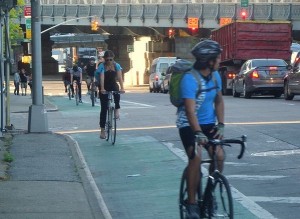Yesterday, for the third time in less than two months, Republican senators failed to eliminate federal money for bike paths, bike lanes, walking paths and other transportation “enhancement” projects. In this instance, the “enhancements” also include pedestrian safety projects. So we’ll chalk this up as a win for the little people. The, you know, 99 percent.
The pro-cycling group People for Bikes—which claims that it and its partners orchestrated a letter-writing blitz that landed 50,000 communications on the Senate in just 48 hours—said the vote “affirms bipartisan support for cost-effective investments in facilities that make bicycling and walking safer and easier.”
In its coverage, the Associated Press pointed out that the latest attempt, an amendment by Sen. Rand Paul, R-Ky., wouldn’t have just allowed the states more latitude on how they spent the rather sizeable pot ($927 million during fiscal 2011) of enhancement money. According to the news agency, Paul’s amendment would have “forbidden the government from spending any money on enhancement projects and re-directed funds to bridge repairs.” (Emphasis added.)
Do we care about bridge repair? Yes, we do (although our fervent belief in the crumbling infrastructure was challenged by Charles Lane’s op-ed in Monday’s Washington Post.) Do we think that bike lanes and pedestrian safety projects are “enhancements” like daffodils in the median? No, we don’t.
The AP story took a couple of hard shots at Paul: it accused him of exaggerating and misrepresenting how the enhancement money would be spent and what his amendment did. It also pointed out that the $927 million constitutes about 2 percent of federal highway funding, which strongly suggests that there is a lot of money to spend on those bridges.
So, three wins in two months. We’re not done with this, though. Long-term infrastructure spending will be on the docket in the House and the Senate over the next few months, and the chairman of a key House committee has already announced that the House bill will try to cut the requirement that states set aside a portion of their funding for “enhancements.”
Photo of New York City bicycle commuters by Jim Henderson via Wikimedia Commons










